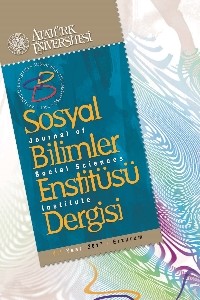Research Article
Cari Açıkların Sürdürülebilirliği: Bir Derleme
Abstract
Keywords
References
- Ağaslan, E. (2008). “Türkiye’de Cari Açıkların Boyutları ve Sürdürülebilirliği”,Gazi Üniversitesi Sosyal Bilimler Enstitüsü, Ankara
- Bubla, F. (2003). Is The Usa's Current Account Sustainable, Bearbeitungszeit, 1-67.
- Caldéron vd. (1999). “External Sustainability A Stock Equilibrium Perspective”,World Bank Policy Research Working Paper, 2281, 1-31.
- Cashin, P. ve Mcdermott, C. J. (1998). “Are Australia's Current Account Deficits Excessive?”,The Economic Record, Blackwell Publishing, 74/227, 346-361.
- Corden, W. M. (1994). Economic Policy, Exchange Rates and The International System,Oxford University Press, New York.
- Dornbusch, R. (1993). Stabilization, Debt and Reform-Policy Analysis for Developing Countries, Harvester-Wheatsheaf, London.
- Edwards, S. (2001). “Does The Current Account Matter?”,NBER Working Paper, (8275), 1-69.
- Freund, C. ve Warnock, F. (2005). “Current Account Deficits in Industrial Countries:The Bigger They Are, The Harder They Fall”, University of Chicago Press, 133-167.
- Hirst, P. ve Thompson, G. (1999). Globalization in Question (2. b.), Oxford Polity Press.
- Holman, Jill A. (2001). “Is The Large U.S. Current Account Deficit Sustainable?”, Economic Review-Federal Reserve Bank of Kansas City, 86 (1), 5-23.
- Isard, P. vd. (2001). “Methodology for Current Account and Exchange Rate Assessments”, International Monetary Fund Occasional Paper(209), 1-39.
- Labonte, M. (2010, 05 02). “Is the U.S. Current Account Deficit Sustainable?” 06 07, 2016 tarihinde www.crs.gov: http://fpc.state.gov/documents/organization/141590.pdf adresinden alındı.
- Mançellari, A. ve Xhepa, S. (2003). “Current Account Sustainability”, Bank of Albania and Faculty of Economics, 1-23.
- Mann, C. L. (2002). “Perspectives on The U.S. Current Account Deficit and Sustainability”, Journal of Economic Perspectives, 16 (3), 131–152.
- Milesi-Ferretti, G. M. ve Razin, A. (1996a). “Current Account Sustainability”, Princeton Studies in International Finance, 81, 1-78.
- Milesi-Ferretti, G. M. ve Razin, A. (1996b). “Sustainability of Persistent Current Account Deficits”, NBER Working Paper (5467), 1-33.
- Milesi-Ferretti, G. M. ve Razin, A. (1996c). “Current Account Sustaınability: Selected East Asıan and Latın American Experıences”, NBER Working Paper Series, 5791, 1-50.
- Moon, B. E. (2000). “Reconsidering Outward-Oriented Development After The Asian Financial Crisis”, The Annual Meetings of The International Studies Association, 1-27.
- Obstfeld, M. ve Rogoff, K. (1996). Foundations Of International Macroeconomics, MIT Press.
- Ostry, J. (1997). “Current Account Imbalances in ASEAN Countries: Are They a Problem?”, IMF WorkingPaper, 97 (51), 1-31.
- Özmen, E. (2004). “Cari Açık ve Ekonomi Politikaları Üzerine”, İktisat, İşletme ve Finans, 19 (223), 5-19.
- Pitchford, J. (1995). The Current Account and Foreign Debt, Routledge, 1-207.
- Reisen, H. (1998). “Sustainable and Excessive Current Account Deficits”, OECD Development Centre Technical Paper, (32), 1-34.
- Roubini, N. ve Watchel, P. (1997). “Current Account Sustainability in Transition Economies”, NBER Working Paper, (6468), 1-72.
- Roubini, N. ve Watchel, P. (1998). “Current Account Sustainability in Transition Economies”, NBER Working Paper Series, (6468), 1-72.
- Sighvatsson, A. (2001). “The Current Account Deficit in An International and Historical Context”, Central Bank of Iceland Monetary Bulletin, (1), 24-41.
- Wirjanto, T. S. (1999). “Emprical Indicators of Currency Crises in East Asia”, Pasific Economic Review, 4 (2), 165-183.
- Yan, H. D. (2007). “Does Capital Mobility Finance or Cause a Current Account İmbalance?”, The Quarterly Review of Economics and Finance, 47, 1-25.
There are 28 citations in total.
Details
| Primary Language | Turkish |
|---|---|
| Journal Section | Makaleler |
| Authors | |
| Publication Date | September 20, 2017 |
| Published in Issue | Year 2017 Volume: 21 Issue: 3 |

